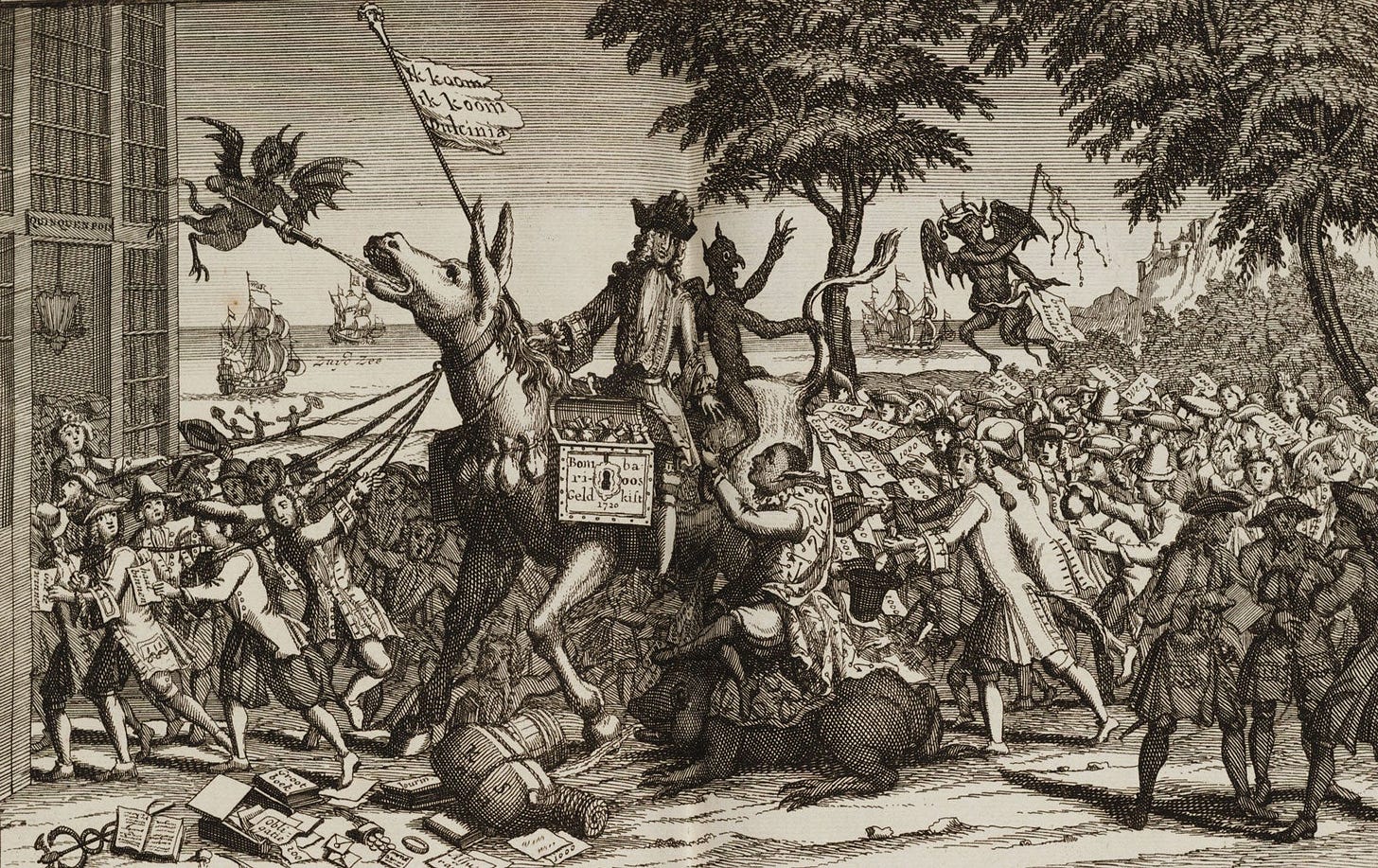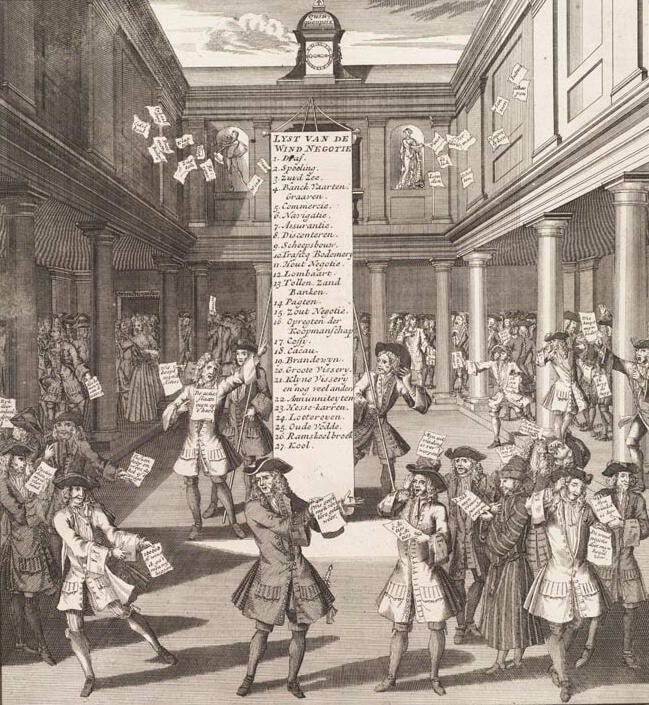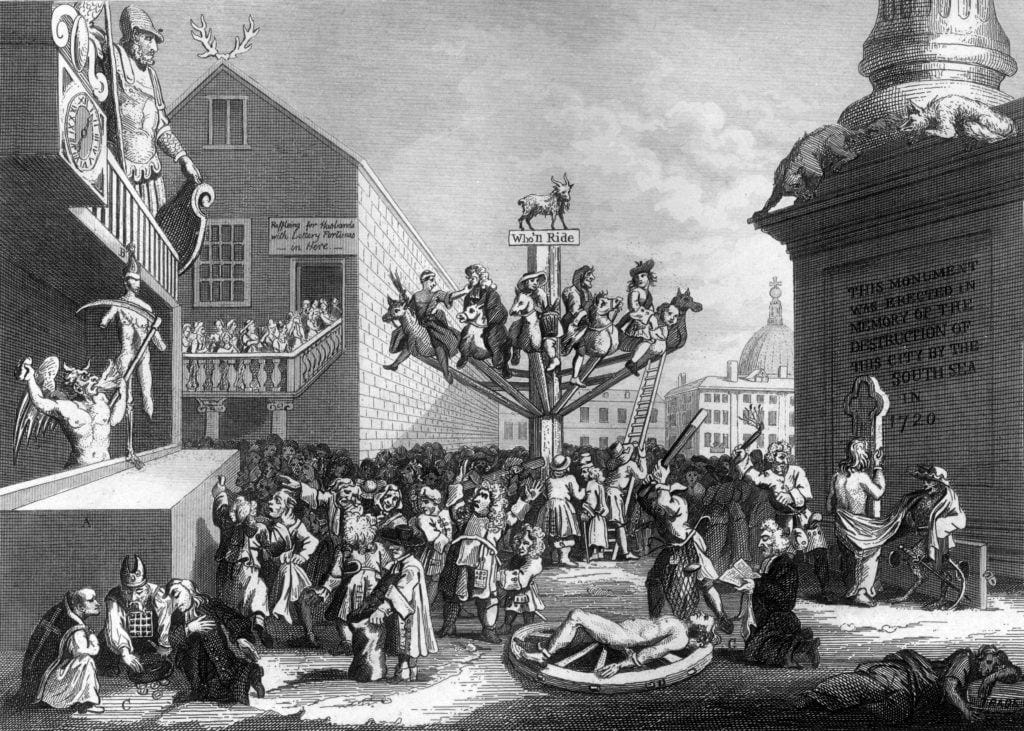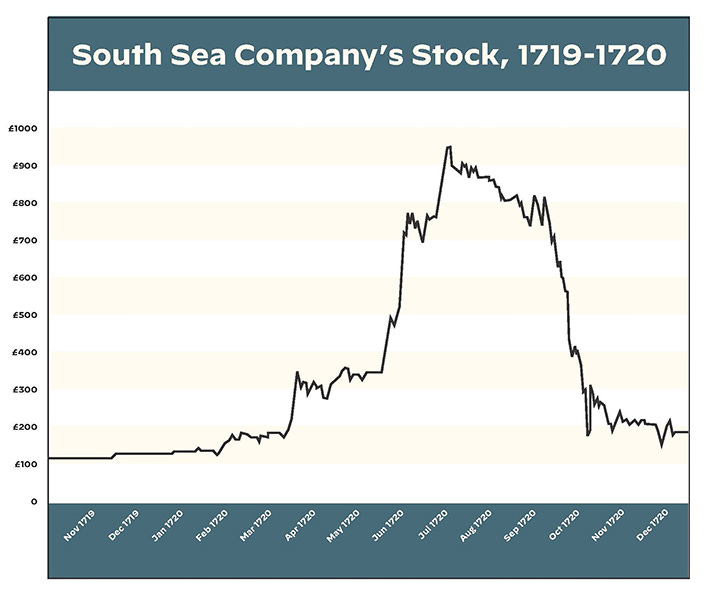In 1720, Europe experienced two financial crises: the South Sea Bubble in Great Britain and the Mississippi Bubble in France, and together they contributed to the first international stock market crash. It was a first modern day crisis that would be very familiar to us and for the first time involved money, credit and other financial instruments as we know them today. Europe was seized by a mania for investing in the expanding trade in the New World and in what is now recognized as the first modern stock market bubble, stock prices soared and then collapsed. Entire continent was gripped in some sort of speculation, with three major ones in Britain, France and the Dutch Republic along with about a dozen of smaller ones.
In midst of this carnage and panic, came a beautiful collection of Dutch art and literature, titled, “Het Groote Tafereel Der Dwaasheid”, or “The Great Mirror of Folly” in English. It was a work of satire containing plays, poems, pamphlets and portraits produced by artists and writers from all corners of the European continent that poked fun at the of investing in stocks and people involved in it. While it might have been exaggerated a bit, the sad state of mania and consequences portrayed by the Tafereel, filled with portrayals of bankers who resemble demons and ghouls as well as images of stockbrokers flinging themselves from windows, depicting the consequences of the 1720 collapse was intended as a warning for future generations.
Studying the South Sea bubble is fascinating and though separated in time by three centuries, it still seems very familiar to us. It is also a mirror into the follies of human thinking, which fall prey to the same delusions periodically.
The above picture is a depiction of the stock trading in London in the early 1700’s. The list contains all the shares and commodities that were traded. To best understand how it was during those heady times in London, consider what Edward Chancellor wrote in his book, Devil Take the Hindmost:
· “Take a contemporary investment banker, dress him in a wig, frock coat, breeches, stockings, and a pair of buckle shoes and send him back in time to Exchange Alley in the 1690s. It is a narrow street in the City of London winding between Cornhill and Lombard Street, where meat, fish, fruit, and vegetable vendors ply their wares. The banker makes his way to Jonathan’s, one of the numerous coffee houses in the alley. He sees a well-dressed man enter the coffeehouse. "How go the stocks?" he inquires of a Jewish gentleman, who, extracting himself from a huddle of drab-looking men in Puritan garb, goes to greet him. "What stocks have you to dispose of? What price for Loftings or Blue Paper? How much an East India put?" The banker starts to cheer up, for he recognises at least some of the language of interests, discounts, transfers, tallies, debentures, shares, and projects which fills his ears. He beckons the stockjobber to his side for an explanation. The jobber tells the modern banker a familiar tale of a wave of exciting new technology companies coming to the market, of rising share prices and record stock turnover, or newfangled financial derivatives, of credit wildly extended, of stock market rumours and sharp practices, and of naïve investors rushing to buy shares. Finally, the jobber speaks excitedly of the profits which he intends to make from this hullabaloo. The time traveller smiles knowingly, he is beginning to feel himself quite at home; the past is not a world he has lost.”
As Charles Mackay observed in his book, Extraordinary popular delusions and madness of the crowds: “Every age has its peculiar folly—some scheme, project, or phantasy into which it plunges, spurred on either by the love of gain, the necessity of excitement, or the mere force of imitation.”
The late 1600’s and early 1700’s was one such period. Europe was caught in the frenzy about enormous possibilities that the newly discovered lands of the “New World” generated and the opportunities they provided. It was also a period of all sorts of innovation, new thinking, a period of infinite possibilities following the discoveries of Galileo and Newton, a period of enlightenment. The European states and their fledging overseas empires were in a constant state of war pushing to develop beneficial trade networks and economic systems. People were speculating in commodities that were coming from the New World, such as Coffee, Sugarcane and Cocoa. At the heart of this struggle was the Atlantic trade, which was fundamentally based on the plantation system and slavery. Underlying these ventures and aspirations was money and finance: the states needed to finance their wars, entrepreneurs needed money to finance new inventions and discoveries, and cities needed to create new infrastructure. All this required new ways to think about money and to raise capital.
One such innovation that took hold in London after the Glorious Revolution of 1688, when William of Orange ascended to the throne was the emergence of the stock market, one of the many other money related innovations that was termed as Financial Revolution. This included a parliamentary guarantee for government loans and led to the creation of “National Debt”, a first of its kind and the establishment of the Bank of England in 1694 with permission to circulate a paper currency. These were followed up with the introduction of the Exchequer bills in 1696, and the Promissory Notes Act of 1704, which made all debts negotiable and transferable. These innovations were essentially introduced to finance the wars against the French.
Credit was the Siamese twin of speculation; they were born at the same time and exhibited the same nature. They were inextricably linked and could never be totally separated and as a result the 1690’s also saw the rise of a new breed of speculators, unprincipled and self-seeking characters, who turned the financial innovations of the day to their personal advantage.
The South Sea Bubble of 1720 has been called the world’s first financial crisis, world’s first Ponzi scheme, speculation mania and a disastrous example of people falling prey to group think. Some of the greatest thinkers at the time succumbed to it, including Isaac Newton, who is supposed to have lost equivalent of £40 million of today’s money in the scheme. But what actually happened?
It all began in 1711, when “The South Sea Company” was floated as a British joint stock company by an Act of Parliament. It was designed as a public-private partnership with the intention of consolidating, controlling and reducing the national debt and to help Britain increase its trade and profits in the Americas. In the century before, one of the most profitable trades across the Atlantic was in trading slaves. To further enhance the trading and profits, the company was given monopoly on slave trade with the Spanish and Portuguese colonies in South America. This scheme generated huge public confidence as many expected profits to increase dramatically, especially when the War of the Spanish Succession came to an end and uninhibited trade would continue with Spain. Unfortunately, the expected trade explosion did not happen. Spain not only limited what Britain could trade, taxed all imports, put restrictions on the number of slaves per year and also the number of ships. This was a big blow to the company as it was unlikely to generate profits needed to sustain its operations and true to the expectations, never turned profitable, But it found an indigenous plan that made it a financial enterprise by default.
In 1715, and then again in 1719, the company was allowed to convert additional government debt into shares. In April 1720, South Sea won approval to buy the remaining government debt and to issue stock in exchange. Parliament allowed the South Sea Company to take over the national Debt. The company purchased the £32 million national debt at the cost of £7.5 million. The once-burdensome debt had been cleverly repackaged into a valuable commodity with the full backing of the government and monarchy. This endorsement instilled a false sense of confidence among the public and inflated the stock. The purchase also came with assurances that interest on the debt would be kept low and the idea was to use the money generated by the ever-increasing stock sales to pay the interest on the debt. Soon the stock entered bubble territory as it started returning one hundred percent interest. The company itself was nowhere close to generating that kind of revenue or profits to meet the promises. Instead, it was just trading in increasing amounts of its own stock and those involved with the company began encouraging and even bribing their friends to purchase stock to further inflate the price and keep demand high. The value of the South Sea Company stock continued to rise from January to July 1720 and by August 1720 the stock price came close to an astronomical sum of £1000. The company aggressively encouraged the purchase of more shares through instalment plans and loans. As shares rose in value, less stock was needed to buy the government debt, and surplus shares could be sold at increasingly higher prices. Anticipating that its stock values would continue to rise, the company paid out far more than it took in.
Then in September 1720, the inevitable happened. The Bubble finally burst with stock values plummeting from £950 a share in July to £400 a share in September to £185 share in December 1720. Many British as well as Europeans who invested in the South Sea Company lost their fortunes overnight, and those who had bought shares at high prices or on credit faced bankruptcy. The rate of suicides spiked. The banks that lent money to speculators faced losses as they couldn’t collect the money from borrowers. There was widespread anger and discontent in the streets of London with the public demanding an explanation. Even Newton himself couldn’t explain the mania and hysteria that had overcome the people and is supposed to have uttered this famous line: "I can calculate the movement of the stars, but not the madness of men".
Together, the South Sea Bubble along with the Mississippi Bubble in France and other highly speculative enterprises that failed in England, France, and the Dutch Republic that year contributed to the first international stock market crash.
Final Words – Have we learnt anything?
The emphatic answer is a resounding “NO”. We learnt from history that we don’t learn from history! Look at the number of manias and panics in just one country, the USA in the past two centuries, to highlight a few:
· Panic of 1837
· Panic of 1893
· Panic of 1907
· Crash of 1929 and the Great Depression
· Crash of the 1960’s
· The Dot Com Bubble
· Panic of 2008 and the Great Recession
Human behaviour has a habit of repeating in cycles, but every time we seem surprised at manias and panics. As I had written in an earlier article from a year ago, Investment Lessons from 400 Years of “Confusion of Confusions”: In 1896, Gustave Le Bon the French psychologist and sociologist, brilliantly caught the actions and moods of the crowd:
· “The sentiments and ideas of all the persons in the gathering take one and the same direction. . . . A collective mind is formed . . . presenting very clearly defined characteristics. The gathering has thus become . . . a psychological crowd.”
The most striking according to Le Bon was:
· “A crowd’s inability to separate the imaginary from the real: “A crowd thinks in images, and the image itself immediately calls up a series of other images, having no logical connection with the first. . . . It accepts as real the images evoked in its mind, though they most often have only a very distant relation with the observed fact. . . . Crowds being only capable of thinking in images are only able to be impressed by images.”
Contagion and crashes are a good starting point for understanding psychological behavior in the markets. One of the most remarkable characteristics of speculative manias is their similarity from period to period, even if hundreds of years apart. Each mania had sound beginnings and was built on a simple but intriguing concept but was then characterized by the almost complete abandonment of prudent principles that had been followed for decades, if not generations. People believed each bubble offered opportunities far more enticing than they had ever seen before. In each mania excessively risky actions were justified as prudent.
· In science and technology, progress is cumulative, but in finance and investing, progress is cyclical








Another superb one Peri Sir! - 🇨🇭